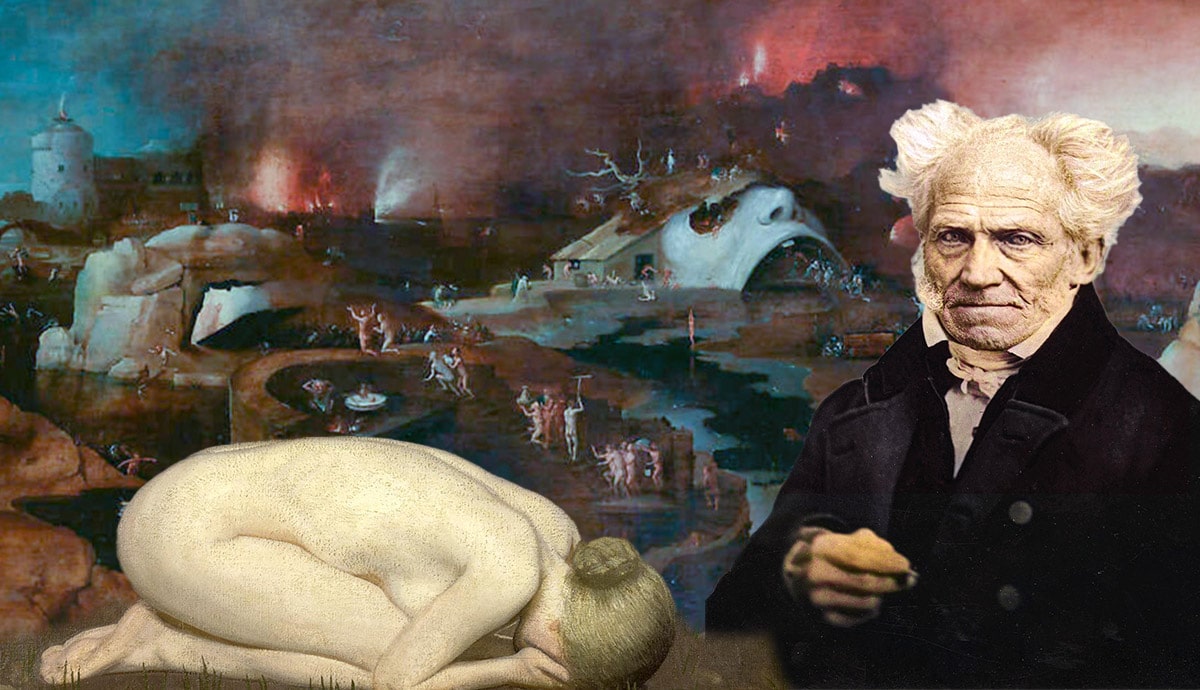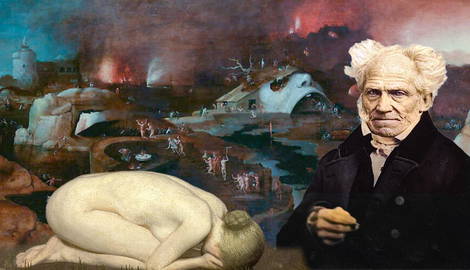
It is unsurprising that Arthur Schopenhauer had a gloomy view of existence. His mother disliked him, his father committed suicide, and he himself spent most of his life isolated in a small apartment in Frankfurt. For him, the very fabric of life was composed of suffering. However, he did have solutions to combat the horror of existence. Among some of his theories, one thing he believed to offer respite was that of art and aesthetic encounters. In this article, we dive into his philosophy of life as suffering and his solutions to it.
Arthur Schopenhauer’s Cycle of Suffering

Schopenhauer’s philosophy of pessimism was based on two claims: that non-existence is preferable and that our world is the worst of all possible worlds. Let’s take a look at this first claim.
He argues that we are forever – in one way or another – in need of something; we feel that we are lacking. This perception of insufficiency may be real or illusory. For example, we may be without food and the means by which to acquire it, causing us to starve. Equally, we may want the newest iPhone but lack the money to purchase it. Either way, we lack these things and therefore suffer from our perception of lacking.

However, as humans, we try to put an end to this suffering by attaining what we lack: earning money to buy food or the new iPhone. This is what he calls ‘striving.’ In his opinion, striving has two ends.
Either, our striving is successful and we attain what we previously lacked. Or, we fail in our striving, and our suffering is now twofold, as not only do we lack but we have to face the reality of our failure too. Yet, things don’t end here.

In the case of having successfully strived and attained what we wanted, he argues, our escape from suffering and consequential satisfaction is only momentary. Soon after buying the iPhone or acquiring the food, we quickly become bored by these things, causing a new perception of lacking to return. This leads only to more striving and, therefore, more suffering. As put by Schopenhauer:
“desires are unlimited, [their] claims inexhaustible, and every satisfied desire gives birth to a new one”
(Janaway, 2013).
Thus, in accordance with his philosophy, life is a cycle of continual suffering, in which one’s state of momentary satisfaction is merely suffering yet to form; i.e. suffering soon to come.
The Three Solutions

Intrinsic to this cycle of suffering is desire: the desire to attain and to alleviate. In other words, it is our very connection to the world (i.e. our stake in it) that causes us to suffer.
Schopenhauer called this our ‘will-to-life’; our self-centered view of the world in which phenomenal reality (i.e. the world as perceived by the senses) is divided and categorised based on its usefulness in our game of attaining and alleviating. Therefore, he argued, by cutting the ‘thousand threads of willing’ that bind us to the world, we can escape this cycle of suffering (Janaway, 2013).
He suggested a few ways of doing this (of how we can deny our ‘will-to-life’). More specifically, he posited three possible pathways to enable us to alleviate the suffering innate to life. Namely, via:
- Asceticism.
- Compassion.
- Art and aesthetic experience.
We will now analyse these possible pathways in a little more depth.
Asceticism as a Solution to Suffering

The most extreme pathway to the alleviation of suffering is asceticism. Asceticism is simply the denial of all pleasure. The term describes the severely disciplined life associated with that of celibate monks and priests, in which the denial of sex, food, alcohol and many other pleasures is required.
Following in line with the Buddhist and Hindu traditions, Schopenhauer argued that by cutting all pleasures from one’s life, desire and the related ‘will-to-life’ could be permanently eliminated. As the ‘will-to-life’ is the very thing responsible for all human suffering, one could free themselves from this suffering by denying the thing that perpetuates it (i.e. desire). In the same way the successful Buddhist eventually reaches a state of nirvana, free from all temporal desire, the successful ascetic will reach a state of ‘will-lessness,’ resulting in a similar sort of serenity.
However, he understood human nature, himself by no means an ascetic. He admitted that the overwhelming majority of people lack the interest and/or discipline to be true ascetics, and will thus never overcome the suffering of life by following this pathway. Thus, he posited a second option.
Philosophy of Compassion

According to Schopenhauer, if one cannot follow asceticism, one can at least be compassionate. But why compassionate? you may ask.
Without becoming lost in the rather confusing depths of his metaphysics, it is necessary to outline his metaphysical stance in order to understand the relevance of compassion as a means by which to escape suffering. As previously stated, he saw the ‘will-to-life’ as the root of all suffering. And this concept of ‘will’ can be thought of primarily as our wish to continue existing and to procreate.
This ‘will’ is the fabric underlying all of reality. For him, will is the only ‘objective’ reality separate from that of our minds, i.e. distinct from phenomenal experience. This was a key idea of his philosophy, evident in the title of his work The World as Will and Representation.
Key to the concept of will is that it is present (immanent) in every aspect of reality. In other words, it is the whole of reality, inclusive of ourselves, the organic and the inorganic world. Thus, it follows that there is no distinction between things; no individuals, no self, no divisions – it is all will. Therefore, reality is one.
From this, he puts forward, it is only logical to treat fellow humans, animals and everything in the world with compassion, as everything is us. Thus, to be compassionate is to treat oneself well. And to be compassionate is also to recognise that the whole of reality is indeed composed of will, and thus to be able to detach (or at least distance) oneself from this will and consequent will-to-life (thereby removing oneself from the associated suffering).
Art and Aesthetic Encounters

While being compassionate is a more reasonable request than becoming an ascetic, it still requires the person to develop a specific approach to life. However, there is a third, temporary solution one can employ to alleviate the suffering of life. This is through art.
Upon aesthetic contemplation, Schopenhauer described the following as the result:
“the attention is now no longer directed to the motives of willing, but comprehends things free from their relation to the will. Thus it considers things without interest, without subjectivity, purely objectively … Then all at once the peace… comes to us of its own accord, and all is well with us”
(quoted in Janaway, 2013).
Upon the contemplation of an artwork, the viewer is able to detach themselves from willing. They are momentarily suspended from the will-to-life, i.e. from desire and striving. In effect, they ‘lose’ themselves in the artwork, to the degree that they forget they are an individual governed by will, instead becoming one with the work of art.
But how is this possible?
He conceptualizes art as a ‘Platonic idea.’ By this, he means that art and the good artist aspire to replicate objects in their most undistorted form. In other words, the artist who paints a landscape tries to paint it ‘as it really is’ rather than how they perceive it to be. Thus, art aims to capture objectivity.

For example, when an artist paints a flower, their aim is to capture the true essence of the flower and its ‘ur’ (intrinsic qualities). In so doing, the artist creates an image of the flower which is universal, and thus closest to objectivity.
For him, art sits between will and representation. In other words, it is a form undistorted by phenomena (our own perception of things) and is thus not representation, but is equally separate from the will (the striving innate to life). Therefore, art in its highest form is the closest to objectivity we can come.
Thus, to view a work of art is to come closer to the ‘real’ nature of things, which itself implies that the viewer understands what reality is really composed of (i.e. will). It follows that through this recognition the viewer is able to momentarily detach themselves from this will and is able to look upon the true nature of things, liberated from pressures of the will.
Schopenhauer’s Favorite Art Form

According to Schopenhauer’s philosophy, there were five art forms through which one could be liberated from the suffering of life. These were architecture, poetry, painting, sculpture and music. However, he did not hold these in equal accord. Specifically, he deemed music to be the highest form of art. This is because he argued, music embodies the will that underlies life itself. What did he mean by this?
Unlike sculpture or painting, whose artists attempt to replicate a Platonic idea, music is ‘the copy of the will itself.’ In other words, music embodies the very will that underlies the whole of reality. This explains why music is considered to be a universal language. This is why movie soundtracks and music set to a specific scene, for example, serve as the perfect commentary upon them and enhance the experience of viewing. Furthermore, music embodies the will – the very thing of life and reality – but leaves aside the practical concerns that are bound up in it. By this, it is meant that we can experience the will without actually suffering from its usual concerns.
For example, a piece of music that evokes a melancholy feeling allows us to experience and consider the emotion of sadness common to life, without actually making us sad. It is at once both a detached and involved experience. Thus, music allows us to understand the very thing that underlies reality (will) without tying us to it. Hence, music – even more so than with other art forms – takes us closer to objective reality.

Similarly, as music is only limited by time and not space (the two factors limiting our perception of things), it is one step further removed from phenomenal reality, and is thus one step closer to accessing an objective reality.
Overall, Schopenhauer offers multiple solutions to his philosophy of life as suffering. These solutions not only alleviate the suffering, but also allow the enlightened person to gain a greater knowledge of reality: of the oneness of things and their true form. While asceticism may be too great a task, and compassion of similar difficulty, aesthetic appreciation is something common to the daily lives of us all. So, the next time you find yourself lost in portraiture or subsumed in a sonata, consider that you are one step closer to the true nature of things.










